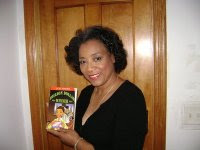Is Austin a neighborhood or a community? According to city maps, we are definitely a neighborhood, based strictly on boundaries of the land. But in terms of being a community with common interests-that is something we need to work at.
To be a community, we need to have a sense of commonality-something that unites us. In accord with that idea, I attended a meeting co-hosted by Rickie Brown, a community activist, and Malcolm Crawford, a contributing writer to this paper and the owner of Sankofa Cultural and Business Center on West Chicago Avenue. Malcolm is also the executive director of the Austin African-American Business Networking Association (AAABNA). Their goal for the meeting is to turn West Chicago Avenue from Cicero to Austin into a "Gateway."
What is a Gateway? The basic premise I have written about for years-that as a neighborhood, Austin is both the entrance to, and exit from, Chicago for the West Side. Yet as a neighborhood, there is nothing welcoming anyone to our area. Nor do we have a common major entity to bind us together into a community.
We are not privy, like other ethnic groups in America, to a shared motherland language, country or culture. What has blended the various African ethnic groups, brought involuntarily to this country together, is the color of our skin. What continues to keep us together is a shared history of slavery and struggles in this country. We have created our own unique African-American culture, juxtaposing the unique and various aspects of regional black culture into one we simply call "Soul."
Black people have lived in Austin for less than 40 years. When blacks first began migrating to Austin, many felt the community, in terms of the housing, would go down the drain. Yet statistically, Austin has the least amount of vacant land of any neighborhood in the city. We don't have blocks upon blocks of vacant lots.
Even more interesting is that, instead of the majority of houses going into disrepair, the majority of homeowners have held onto their property and most have improved it.
For the past 10 years, I have felt there was a move to get blacks to leave Austin. And for a while, it appeared to be happening-with most every house being sold going to a different racial group. But with over 110,000 people living in Austin, blacks will continue to be the dominant racial group for years to come.
As such, shouldn't we acknowledge our presence and celebrate our culture just like Greektown, Humboldt Park, Little Italy, Chinatown or Little Village? To do that we need to establish both visual markings and institutions to put our brand on Austin?
The Gateway Project proposes a couple of things. One of the first is to turn the now defunct 15th District police station at the corner of Lockwood and Chicago avenues into the Leona Spann/Ed Bailey Center. It would be remodeled in African motif and become the center of the social, business and cultural life for Austin. In addition, the Gateway Project also proposes placing African-inspired arches along Chicago Avenue to identify the gateway district.
What the Gateway Project needs most now is the support of the community to turn this idea into a reality. The Gateway Project is in the midst of planning its annual Juneteenth celebration at Chicago and Mayfield avenues.
We need people to make this the best Juneteenth ever, and to help get the word out so the community will come out and support the vendors, take part in the celebration and just network and socialize, which is how we build community.
The Gateway Project will meet this Saturday, April 19, at the Austin Branch Library, 5615 W. Race from 1 to 2 p.m. You can also get more information by visiting the website at www.rpbconsultinginc.com. Or you can reach Rickie P. Brown Sr. at 773/308-8636






